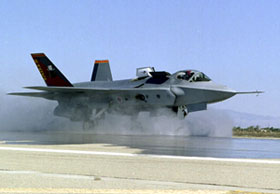INDIAN ARMED FORCES CHIEFS ON
OUR RELENTLESS AND FOCUSED PUBLISHING EFFORTS

SP Guide Publications puts forth a well compiled articulation of issues, pursuits and accomplishments of the Indian Army, over the years

I am confident that SP Guide Publications would continue to inform, inspire and influence.

My compliments to SP Guide Publications for informative and credible reportage on contemporary aerospace issues over the past six decades.
Another Bloomer in F-35 JSF Development Programme!?

A Lockheed Martin spokesman has recently reported from Bloomberg that the Company is in the process of fixing a structural weakness in the Navy version of the F-35 Joint Strike Fighter (JSF) that limits the jet’s ability to launch from aircraft carriers. Programme engineers discovered last July a ‘strength shortfall’ in an aluminum structure in the under development F-35C aircraft’s centre fuselage that helps absorb stresses during a catapult-assisted take-off. However, the matter has been subjected to immediate remedial addressal by the Company’s Programme Office engineers to formulate the necessary design updates. A modification is reported to be already approved for incorporation early this year prior to any catapult testing which incidentally, is planned for 2011. It has also been clarified that there was never a problem with a hook-arrester landing on the carrier.
It may be recalled that the carrier version is the last of the three variants to go into production and is scheduled to be used on carriers operating with the US Navy’s current Boeing F/A-18E/F fighters by 2015. The first development model of the F-35C is planned to get airborne for its maiden flight by August 30.
But there is another matter of concern which needs to be adequately addressed by the designers of the aircraft. A report from Pentagon has brought out that the 40,000+ lb-thrust that the engine and power systems’ exhaust on the Navy and Marine versions is powerful enough to pose a threat to carrier personnel. The blasts also may damage shields used to deflect heat on the deck, including on the CVN-21 carrier, the US Navy’s proud possession and its most expensive warship. Reports indicate that F-35s operating from the CVN-21 will result in damage to the carrier deck environment and will adversely affect hangar deck operations. As the F-35C’s exhaust area is larger than the currently used Boeing’s Super Hornets, the jet blast deflectors used during launch would be vulnerable to warping and failure. Similarly, exhaust from the Marine Corps F-35B version’s integrated power system deflect downward and may pose a hazard to flight deck refueling, munitions, personnel and equipment located on catwalks.
Undoubtedly, the Pratt & Whitney F135 engine of the F-35 JSF, with a massive 43,000 lb (191 kN) thrust with afterburning is the world’s most powerful engine ever fitted on a fighter aircraft and, therefore, heat and exhaust problems for carrier deck operations as described above are bound to surface. However, serious as they may appear at first glance, these are definitely not insurmountable. Permanent solutions would certainly be found by incorporating suitable modifications both in terms of equipment and operating procedures to ensure safe deck operations for both types. These concerns therefore are of temporary nature and should not cause any impediment to the overall JSF programme.





